Magicicada skins (exuvia) blanket the ground around the roots of a tree. This is a photo of periodical cicada skins taken by John Cooley of Cicadas @ UCONN (formerly Magicicada.org) in Warriors’ Path State Park, TN, in 2012. Brood I.
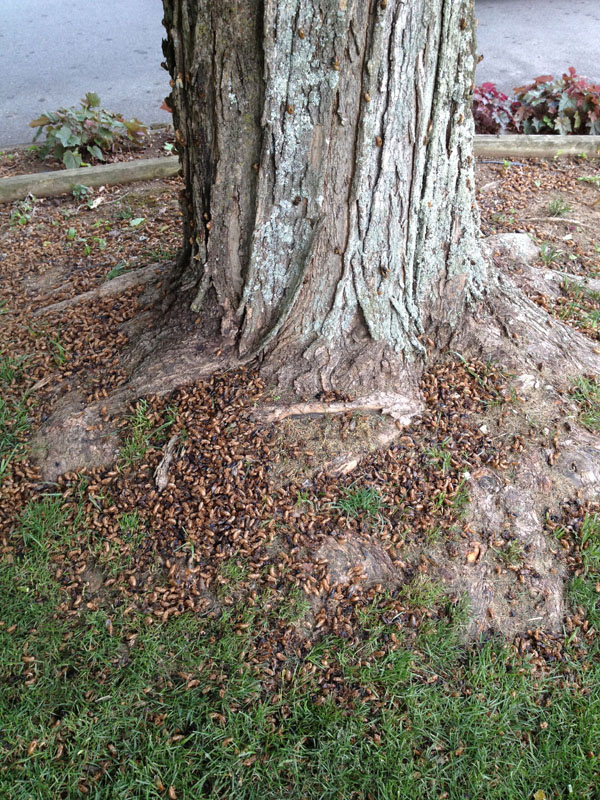
Cicada researchers associated with academic institutions.
Magicicada skins (exuvia) blanket the ground around the roots of a tree. This is a photo of periodical cicada skins taken by John Cooley of Cicadas @ UCONN (formerly Magicicada.org) in Warriors’ Path State Park, TN, in 2012. Brood I.

Cicada Safari App Frequently Asked Questions:

Gene Kritsky working with the Center for IT Engagement at Mount St. Joseph University in Cincinnati.
Probably Gene Kritsky and the Center for IT Engagement is your best route. Be polite. The app has 250,000 users and only a handful of people to approve cicada sightings.
Gene is the Charles Lester Marlatt of the 21st century. Gene is a periodical cicada expert, researcher & professor. Buy his latest book, Periodical Cicadas: The Brood X Edition, now.
Choose wisely: Google Play Store or Apple App Store.
As of June 1st 2021, over 250,000 people have downloaded the app.
Yes, you can! See a map of sightings from the Cicada Safari app.
Of course the app has a website. Here’s the website.
Judging by screenshots of the app, it looks like you can 1) identify cicadas, 2) take a photo and share it, 3) map the location where you found it, 4) compete with other cicada scientists for the most cicadas found. Looks that way at least. The app lets you submit cicadas photos of any species.
Try the iNaturalist apps.
Not that I know of, but you can always ask Gene Kritsky. Feel free to leave a comment on this website or the Facebook Cicada Discussion Group.
Cicada Mania is not affiliated with the Cicada Safari app. Cicada Mania is not paid to endorse or promote it. We promote it because we like it.
Platypleura watsoni, also known as Platypleura mokensis, is a cicada found in Thailand, India, and Myanmar (Burma), and very likely adjacent nations.
Photo by Michel Chantraine:
]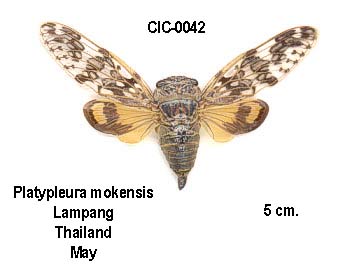
Scientific classification:
Family: Cicadidae
Subfamily: Cicadinae
Tribe: Platypleurini
Genus: Platypleura
Species: Platypleura watsoni (Distant, 1897)
Platypleura hampsoni is a cicada found in India.

Image and Description from A Monograph of Oriental Cicadas by W. L. Distant. 1889-1892. Read it on the Biodiversity Heritage Library website:
Male. Head luteous; front with a number of black linear markings; vertex with a transverse, narrow, black fascia between the eyes, and with a central black spot containing the ocelli. Pronotum greenish-ochraceous, the disk with the following black markings: — a central I-shaped spot, on each side of which are some oblique linear markings; the lateral dilated margins are black, and the anterior margin is narrow — and the posterior margin broadly— dull reddish ochraceous. Mesonotum greenish-ochraceous, with the following black spots: — four obconical from anterior margin, of which the central two are smallest; and a large, oblong, discal spot, with a small partly rounded spot on each side of it; the basal cruciform elevation dull reddish ochraceous. Abdomen above black. Head beneath, with the face black, marked with luteous transverse lines; sternum somewhat ochraceously pilose; abdomen beneath black, the segmental margins ochraceous, the anal appendage of the same color; legs castaneous, streaked or spotted with piceous and luteous. Rostrum black, the basal portion luteous.
Tegmina pale hyaline, with the venation brown, the costal membrane greenish, the basal third somewhat opaque, with darker transverse markings and small basal black markings; a double irregular series of dark brown spots cross the tegmina at about center, a dark brown fascia at bases of upper apical areas, a few small subapical spots and some small marginal spots of the same color. Wings brownish-ochraceous, paler at apex than at base and very pale across the center, with a white marginal spot near anal angle; the venation brown.
The rostrum reaches the basal abdominal segment; the lateral margins of the pronotum are distinctly angulated; the face is robustly gibbous, with a profound central longitudinal sulcation; the posterior tibijE have three distinct spines on each side of apical half.
Long. excl. tegm. 2 . 23 millim. Exp. tegm. 70 millim. ; exp. pronot. angl. 13 millim.
Hab. — Continental India : Neelgiri Hills, northern slopes, 3500 & 5000 feet (Hampson — coll. Dist.).
Scientific classification:
Family: Cicadidae
Subfamily: Cicadinae
Tribe: Platypleurini
Genus: Platypleura
Species: Platypleura hampsoni (Distant, 1887)
For more information about this cicada, visit Cicadas of India.
Platylomia radah is a cicada found in Burma, China, India, Nepal, and Thailand.
Photo by Michel Chantraine:
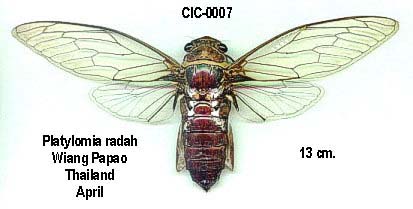
Scientific classification:
Family: Cicadidae
Subfamily: Cicadinae
Tribe: Dundubiini
SubTribe: Dundubiina
Genus: Platylomia
Species: Platylomia radah (Distant, 1881)
For more information about this cicada, visit Cicadas of India.
Platypleura mira is a cicada found in Cambodia, Laos, Malasia, Thailand, and Vietnam.
Photo by Michel Chantraine:
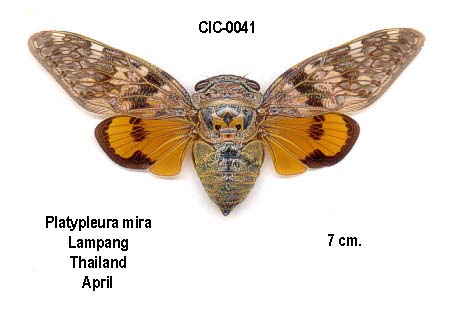
Scientific classification:
Family: Cicadidae
Subfamily: Cicadinae
Tribe: Platypleurini
Genus: Platypleura
Species: Platypleura mira Distant, 1904
Orientopsaltria beaudouini is a cicada found in Malasia and Thailand.
Photo by Michel Chantraine:
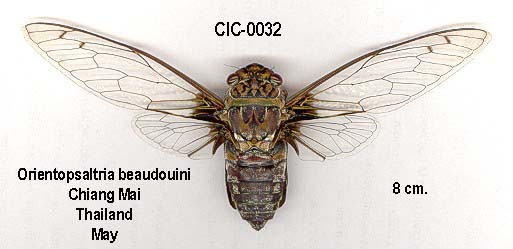
Scientific classification:
Family: Cicadidae
Subfamily: Cicadinae
Tribe: Dundubiini
SubTribe: Orientopsaltriina
Genus: Orientopsaltria
Species: Orientopsaltria beaudouini Boulard, 2003
Megapomponia intermedia is a cicada found in Cambodia, Indonesia, Laos, Nepal, Malaysia, and Thailand.
Photo by Michel Chantraine:
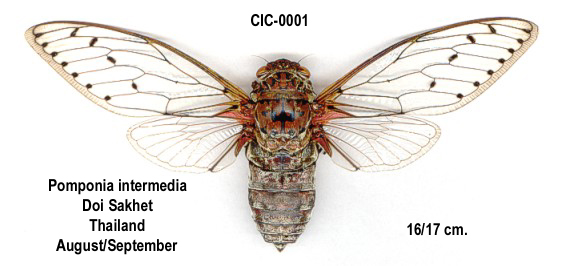
Note: the image reads Pomponia intermedia, but since the time the photograph was taken the name of the cicada has changed to Megapomponia intermedia.
Scientific classification:
Family: Cicadidae
Subfamily: Cicadinae
Tribe: Dundubiini
SubTribe: Megapomponiina
Genus: Megapomponia
Species: Megapomponia intermedia (Distant, 1905)
Megapomponia imperatoria is a cicada found in Cambodia, Indonesia, Laos, Malaysia, Nepal, and Thailand. This is the largest cicada in the world
Photo by Michel Chantraine:

Note: the photo reads “Pomponia imperatoria”, but since the time of the photograph the name of the cicada has changed.
Description 1:
Body above brownish-ochraceous, in some specimens castaneous. Head with a central longitudinal spot to the front, the area of the ocelli, a transverse spot behind eyes, and a spot at anterior angles of vertex, black. Pronotiim with two central longitudinal linear fasciae not extending beyond center — a central spot at the posterior margin — and the furrows black; posterior margin greenish, with two black spots on each side. Mesonotum with two obconical central spots, from the junction of which a longitudinal fascia extends to posterior margin, four spots in transverse series at the base, a spot on each lateral discal area, and sometimes some small spots at anterior margin black. Abdomen with the posterior margins of the abdominal segments narrowly black. Body beneath and legs brownish-ochraceous; transverse striations and the apex of the face, anterior tibiae, bases, and apical thirds of the intermediate tibiae, anterior and intermediate tarsi and the apex of the rostrum, black.
Tegmina and wings pale hyaline, the venation ochraceous. Tegmina with the costal membrane and basal cell brownish or ochraceous, the claval area ochraceous or sanguineous; the transverse veins at the bases of the second, third, fifth, and seventh apical areas infuscated and a series of fuscous marginal spots at the apices of the longitudinal veins to apical areas. Wings with the base of claval area ochraceous or sanguineous; outer margin of claval area ochraceous.
Long. excl. tegm. Male 46 to 68 millim. ; Female 41 to GO millim. Exp. tegm. Male 137 to 180 millim. ; Female, 145 to 216 millim.
This is a most variable species, both as regards size and markings. The largest specimen I have yet seen is a female in my o\vn collection from Perak, whose tegmina reach an expansion of 216 millim. In some of the smaller specimens, the body is darker, and the markings to same and the spotting of the tegmina very indistinct. There almost seem to be two races of this species, one very much smaller and somewhat less prominently marked than the other.
As I have elsewhere recorded, I captured this fine species myself, not infrequently, when sojourning in the Malay Peninsula. It often frequented the dining-room, and on holding it between the fingers its stridulation caused a thrill through the nerves of the arm.*
Scientific classification:
Family: Cicadidae
Subfamily: Cicadinae
Tribe: Dundubiini
SubTribe: Megapomponiina
Genus: Megapomponia
Species: Megapomponia imperatoria (Westwood, 1842)
Majeorona aper (Walker, 1850) is a cicada found in Brazil, Colombia, Ecuador, French Guiana, Panama, and likely adjacent nations.
Photo by Leonardo Milhomem:
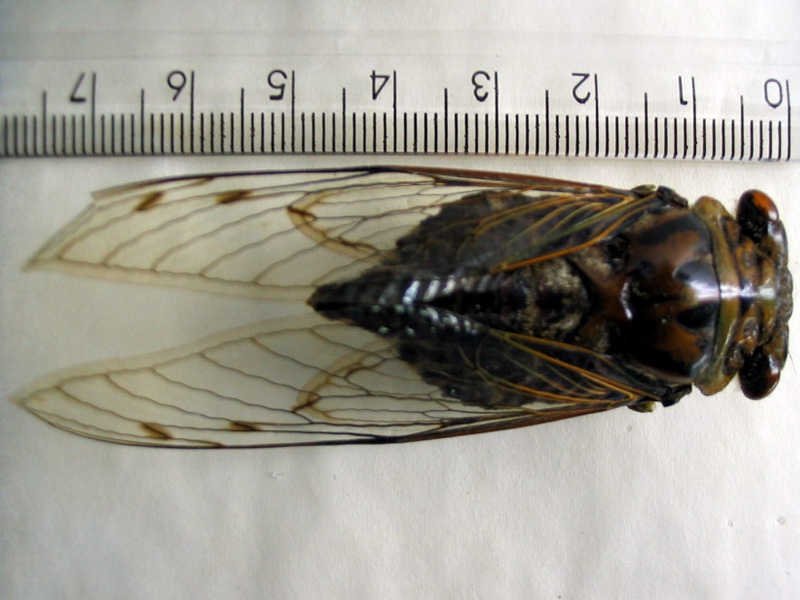
Scientific classification:
Family: Cicadidae
Subfamily: Cicadinae
Tribe: Fidicinini
SubTribe: Guyalnina
Genus: Majeorona
Species: Majeorona aper (Walker, 1850)